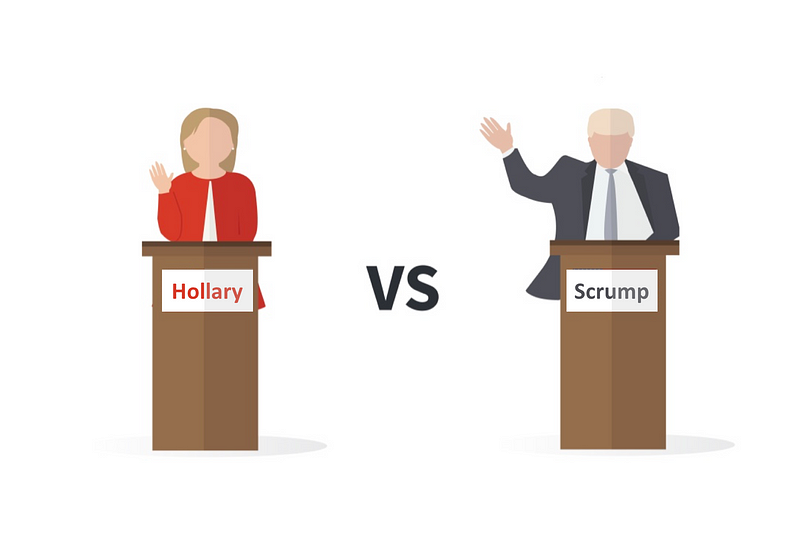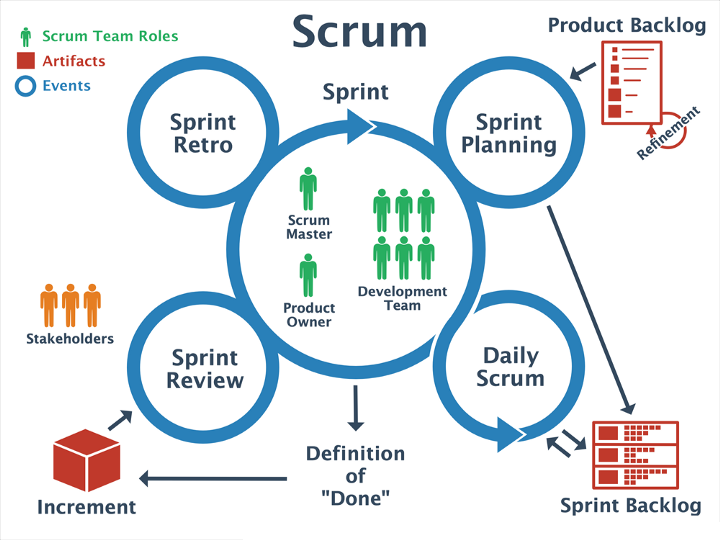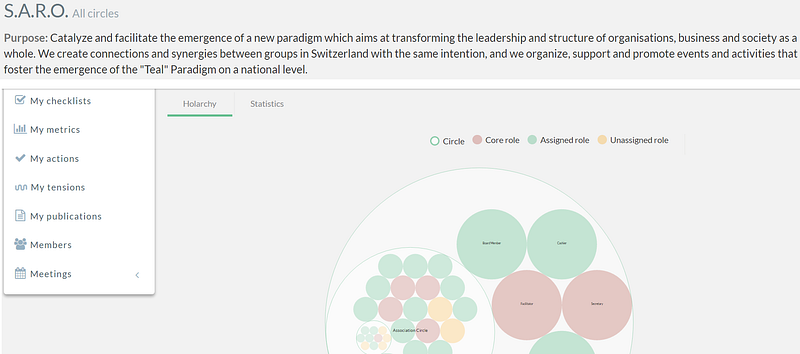By Piero Pierucci and originally published on medium.com
The following comparison of Holacracy and Scrum originates from a workshop held at the SARO (Swiss Association for Responsive Organizations) Teal Camp in early November 2016. To make it more fun for the participants, the workshop session was held as a Presidential Debate between two candidates: Hollary and Scrump. Enjoy the read …

EXPERIENCE AND ACHIEVEMENTS
Moderator: Welcome to all of you, in this workshop and following us at home. As is customary in these debates, you will be taking turns in answering my questions, and each of you will be given two minutes.
Starting with you, Hollary, can you please tell us about your prior experience and achievements. Further, which kinds of companies you are targeting as an electorate?
Hollary: I can build on ten years of experience, and my method has been implemented in companies up to a size almost 2.000 people. Holacracy started spreading in service companies but now is branching out into many different fields. We target purpose-driven companies — purpose being a core concept we should talk about later — as well as companies that seek to increase their flexibility.
We firmly believe that wholeness is an important issue, too. Nobody should be required to put on a “mask” when coming to work, or to behave in a boss-subordinate kind of way. This will, however, require un-learning of much of what we are used to in work. In particular, company leaders must be ready to let go of their power over people.
Scrump: We will Make Work Great Again. For us, it’s all about structuring work effectively, while giving flexibility to respond to changes in market and customer expectations. We use a solid framework and tested methods, with lots of clarity on who is in charge of what. Assigning clear responsibilities helps us to build great products!
Scrum was first used in software development, but then quickly moved on to other areas, from product management to building startups. I tell you: using waterfalls in product development is a total disgrace! Sad! Scrum works in all sizes of organization … from size three to scaled implementations for large enterprises.

VALUES
Moderator: If a company votes for you, what will be the value set they decide to live in?
Scrump: Most importantly, we want to make our customers really, really happy. We believe that customer value can be achieved when the teams seeks frequent interaction with customers, and when the mode of collaboration values individuals over processes. We want to use the full collective intelligence of our teams while maintaining an ordered structure.
Our main values are openness, respect, commitment, focus and courage. To increase effectiveness, we also value a stable process setup, that is: stable teams and stable roles. We should really talk about the power of my roles later on. We have great roles! Within the company, we aim to strengthen autonomy and mastery while making the collaboration as effective as possible.
Hollary: We value purpose over anything else. As a company, we want to make the best possible contribution to society, and this is best done when each of us can bring their best to work. Other systems put pressure on people to get the most out of them. We believe that squeezing will also press the worst out of people. We have experienced the goodness of people — their self-motivation, their self-management, their desire to contribute. Our work is great, because people are good!
We found that traditional use of authority does not foster these qualities, so we use a system of distributed authority. But we also incorporate values from other systems, such as effectiveness, efficiency and accountability.

ROLES
Moderator: Both of you want to govern by assigning roles, but in a very different way …
Scrump: We are very, very clear about roles. We have defined three main roles, the Product Owner, the Scrum Master and the Team. A Product Owner takes responsibility for the commercial success of the product or the project. He has power to prioritize the work items. A Scrum Master operates as a coach, in charge of making the process work, identifying problems early on and bringing some fun to work. The Team takes joint responsibility in deciding how much can be achieved within a certain period of time … and in delivering the committed results! Any of the traditional product/program management and administration are not at the core of Scrum.

Hollary: We are very explicit about roles and responsibilities, nothing like the “do whatever you want” situation some people seem to believe we promote. We go long ways to handle roles as the union of name, purpose and accountability. We have dedicated governance meetings in which we define and revise roles. However, there is no pre-set concept of who should be doing what, as hierarchical organizations would have. If you are ready to energize a role — fill it!
Holacracy is not a fixed type of organization. Rather, it is a toolkit, a set of rules, that will allow you to build and constantly adjust your organization. And the definition of roles is the key instrument in this process.

MEETINGS
Moderator: Meetings take an important part in work. Sometimes, this can be a very tedious part of life. Both of you promise to overhaul the meeting culture. How do you go about this?
Hollary: We make a clear separation on what a meeting is aimed at. We use governance meetings to define, assign and revise roles. This clarifies the layer of “who does what”. Typically, such a meeting will be held once a month and takes 1,5 hours. Secondly, there are tactical meetings that serve to synchronize operations. A tactical will typically be held once a week and take 1 hour.
These two meetings are the backbone that anchors much of the Holacracy practice. But, of course, there will be separate meetings outside of that formal pace whenever organizational needs require it.
Scrump: Experience shows that 20% of work is a fair share of meeting time in a high-performance team. Meetings are defined in the Scrum cycle, and they cover grooming, refining, planning the work that is ahead. There also are daily standups — very short, brisk get-togethers — to synchronize current work status and to make sure that problems are addressed early on. In reviews, the team presents results to clients and stakeholders. This ensures that client requirements are fed into the work stream on a constant basis. Last not least, the team members will convene on a regular basis for a retrospective to look at how they can work together more effectively. It’s all about continuous learning!
Outside these formal meetings, execution relies heavily on 1-to-1 communications. I know, 20% of time for meetings can be daunting for people who are used to living in their awful meeting swamp. But worry not, Scrum meetings are very effective, and they make work very foreseeable.

SETTING PRIORITIES
Moderator: We’ve talked about the HOW of your work. Let’s now look at the WHAT. First of all, how do you go about setting priorities for work or product features?
Scrump: The basic unit for prioritization is the Product Backlog Item (PBI). It is a short text that should be understood as an invitation for a conversation about a piece of work. Often, these will evolve into User Stories, descriptions of the enhanced product experience from a customer’s perspective. It is the job of the Product Owner to distill all kinds of inputs into PBIs, and the Product Owner holds responsibility for prioritizing them. The highest priority PBIs are associated with the maximum possible ROI. But value is time critical. We want to generate value, and we want to do it quick. So sometimes, the WJSF formula helps us to prioritise for the smaller items that still create a lot of value! Once a PBI is accepted by the team into the sprint backlog, the team will break the associated work down into tasks and start doing whatever is necessary to have the PBI’s value delivered for the next sprint review.
Hollary: I said earlier that we assign roles. Every role filler does a weekly review, and projects and next steps are checked and prioritized. For us, individual responsibility is key to prioritization. The role filler is trusted to make the best decisions, sometimes after consultation with others who are affected by the decision. It is central that each role filler has a reliable self-management system in place, all in the Getting Things Done spirit. However, if necessary, the Lead Link can take over prioritization.

POWER
Moderator: Who holds which power in your governance model?
Hollary: We distribute power, so there are no traditional leaders anymore. In Holacracy, work is clustered in circles which are autonomous entities. Power is seeded into the circle’s roles. The power to decide is with the role holder. At the same time, there is the Holacracy Constitution (rule set) that holds for everybody in the same manner. There are no exceptions, and we look closely to eliminate residual power left over from the old days. This makes sure that there is no person holding power over anybody else.
This can be tough to re-learn, and the process of distributing power takes determination — especially by those who are used to holding power today (and enjoying the status associated with it). We have found that people cannot be “convinced” into letting go of power. They must be ready for a complete shift, and leaders must be ready to unlearn most about their current management behaviors.
There is no half-half — it is a complete, radical shift. In the past, we have also seen that this shift did not happen completely, or was reversed, and this can create huge disappointment. Holacracy is something great, but getting there can be hard, and you must be prepared to deal with some pain on the way.
Scrump: Scrum is far more compatible with the current form of power distribution. But senior management also have to let go of some authority to the Scrum Team. As I said earlier, the last call for prioritizing user stories is with the Product Owner. C levels will be consulted in a stakeholder role, not as the earlier “steering committee”. Also, management will better accept that team resources, user stories and the like are binding commitments that should not be changed during a sprint.
Scrum is a very disciplined process, and respect for the process — from all sides — is key. At the same time, a changed set of responsibilities allows a totally different pace and quality level. Not to forget that empowerment creates joy and motivation in the teams, and attracts talent.

SUITABLE ENVIRONMENTS
Moderator: What do you think is the best context, or environment, for implementing your governance model?
Scrump: Scrum is suited for any organization, especially if their work is based on projects. Teams benefit most if they need to navigate in complex markets and complex, maybe rapidly changing environments. It is no coincidence that IT companies were first to adopt it.
Hollary: Also, here, any type of context is suitable. We see it from small service organizations to large-scale production companies. However, there needs a clear top management commitment to let power go completely.

IMPLEMENTATION CHALLENGES
Moderator: Let’s spend some time looking at process of implementing your governance model. What will be the most relevant challenges?
Hollary: The central challenge is that senior leadership needs to let go of decision making power and power over people. Leaders clearly need to step away from traditional leadership habits, unlearn many of their behaviors. It is also crucial to understand the separation of roles and individuals. This is a process that takes time to get used to and external facilitation is important to ensure the transition. I’m not saying “ensure a smooth transition”, because even successful transitions are not necessarily smooth. There is a saying “What is helpful in a pathological organization, can be pathological in a healthy organization”. It takes re-wiring on many sides … Also, it is crucial to have coaches support the individual development of team members to the new organizational practice.
Scrump: We organize work around value streams, not around people, power distribution lines or organizational units. This requires some re-learning in terms of leadership (some of it has been mentioned before). New roles will appear, and some traditional roles will disappear. Some leaders will get the impression as if their power was undermined, because work becomes cross-functional, and this breaks open organizational silos. Leaders will have to adapt to a different rule set. Also, commitments in Scrum can turn out to be more binding than in traditional organizations, e.g. resource commitment (because the Scrum Team is actually using the committed resource …). This brings up over-commitments, as well as other flaws in the current company setup. Some old ways of behaving and thinking will start to look absurd (often because they are!) — and this can generate pushback, especially in top/middle management.

ADOPTION
Moderator: Well, how about people’s reaction to this?
Scrump: Going Scrum can temporarily lead to extra pressure on people. They have to re-learn much about how they work. They might live in conflicting regimes for a while. There might be resource conflicts which are not necessarily related to Scrum as such, but this still places a burden on people. People have to deal with conflicting views and opinions on the organizational issues — this can be hard, and it should be facilitated.
However, on the team level, people usually pick it up quite quickly and start to thrive in a new setup that gives them more responsibility, speed and visibility.
Hollary: Implementing Holacracy takes time to get comfortable with. It is much about changing habits, and this is always hard! Also, some people need time to get used to a very clear ruleset on how decisions are made. This can trigger “dictatorship feelings” in some.
It is absolutely necessary to create a separate “container” for the social dynamics, such as individual 1-to-1 conflicts, feedback and assessment processes, etc. This is not covered in the Holacracy constitution, because “Holacracy governs the organization, not the people”. The people and their social system needs to develop autonomously and separate from the rules of the organization.

INTEGRATING THE TWO APPROACHES
Moderator: We have talked a lot about differences between your approaches. In the final question, rather than asking you what you regard highly about your opponent, I would like to know: to what extent is it possible to integrate parts of the opposing approach into yours?
Hollary: Holacracy was built partly on the agile framework. But it goes beyond Agile and Scrum, it takes the distribution of authority all the way. Certainly, Scrum and Holacracy work together very well and there actually is a Scrum App available that helps to implement Scrum in Holacracy environments.
Still, Holacracy is a complete take-it-or-leave-it approach, and we are careful not to compromise the overall architecture. It is a complete shift to self-organizing the work of an entire organization.
Scrump: I think it just has become clear that Holacracy has advantages for some companies with a very dedicated leadership team. For the most of us, however, Scrum proposes a system that is much more easily accessible, more direct to implement. It also has proven that companies that already use Scrum will make smoother transitions to Holacracy. Scrum is a safer bet, and you can still consider moving on to Holacracy later … more easily than if you take the direct route.
Moderator: Thank you very much for your statements. I hope this will help the audience to take their decisions wisely …





